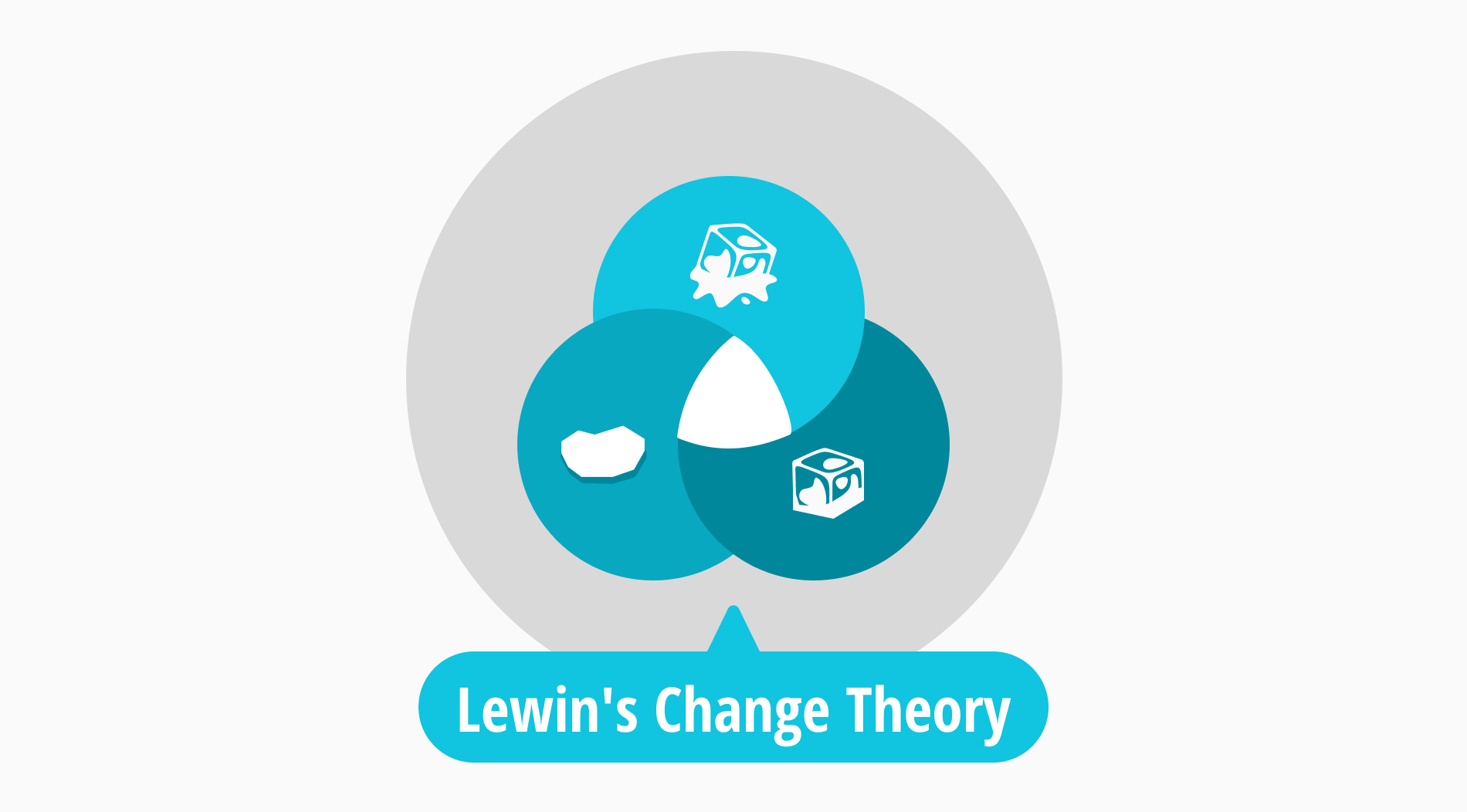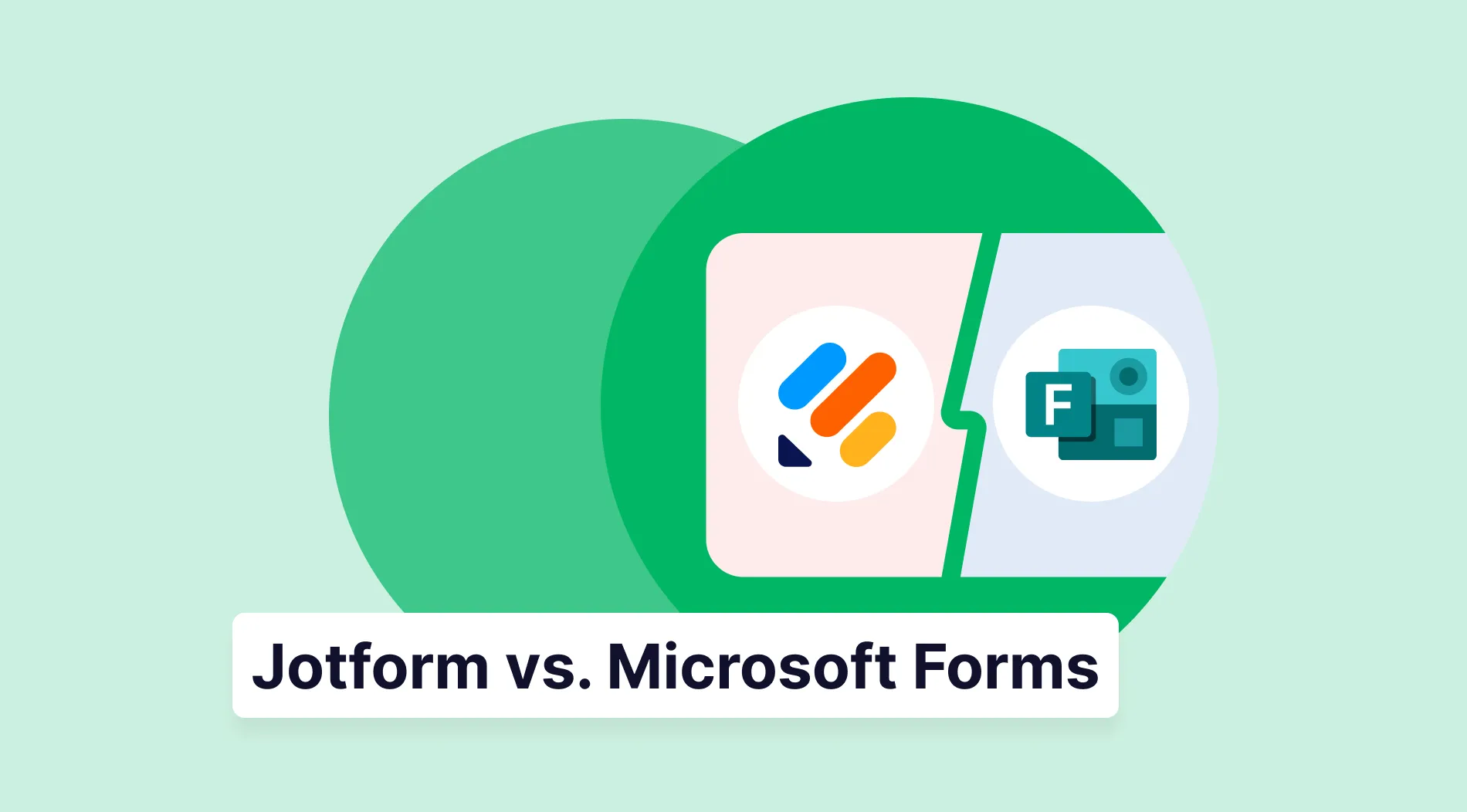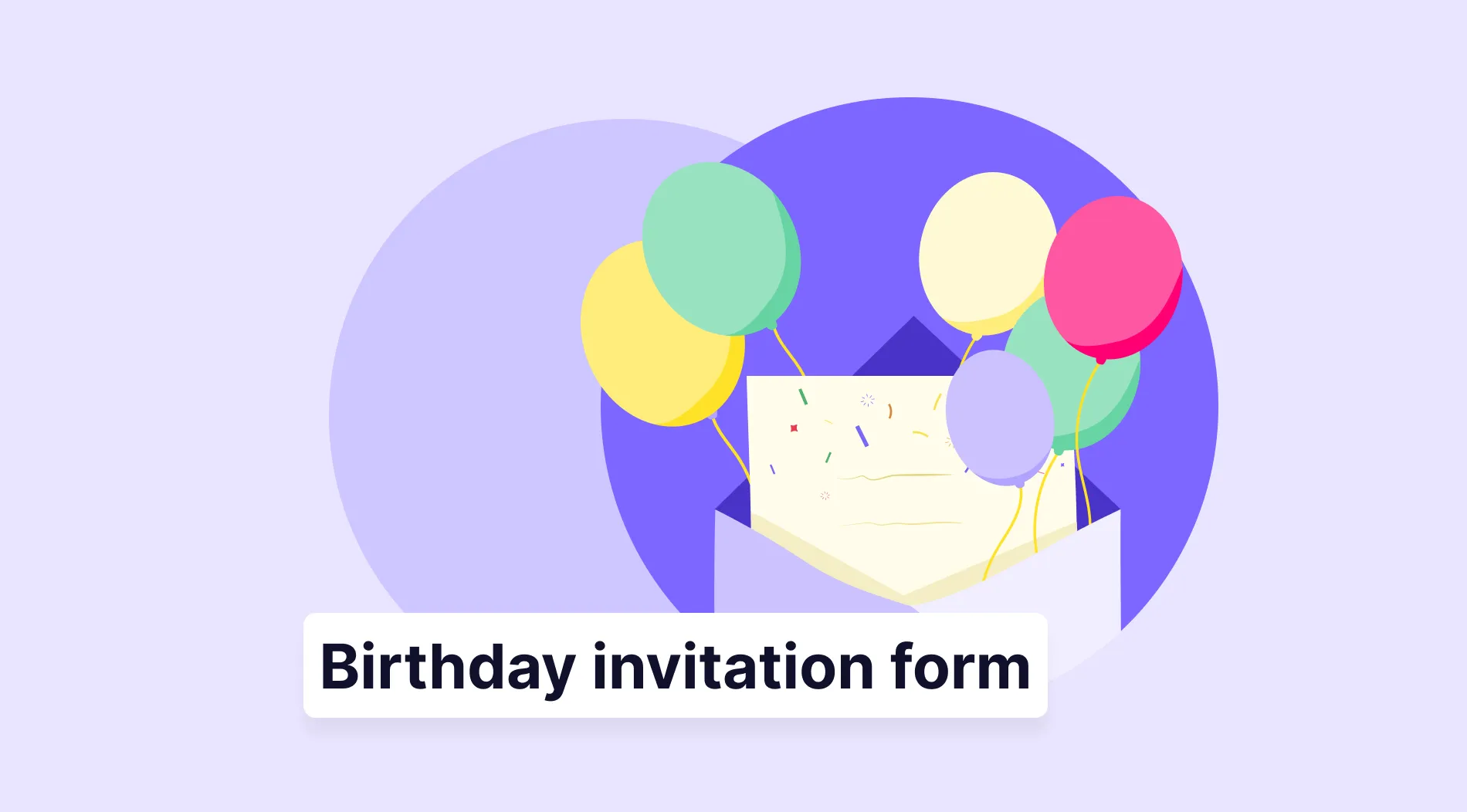In today's fast-paced and dynamic business environment, organizational change is inevitable. Businesses need to manage change well to stay competitive by adapting to market trends, technology, and customer needs. A good system for managing organizational change provides support and strategies to help navigate transitions smoothly. This system ensures flexibility, versatility, and sustainable growth during uncertain times.
This article will cover Lewin's Change Theory, a framework for managing organizational change. We'll explore each stage: Unfreeze, Change, Refreeze. We will provide steps for implementation, scenario examples, suitable cases, and the advantages of the model. Organizations can navigate change more effectively by understanding and applying Lewin's theory and achieve lasting success.
Let’s start with the definition: What is the unfreeze, change, refreeze model?
The Unfreeze-Change-Refreeze model (a.k.a Kurt Lewin Change Model) is a practical framework for managing organizational change.
Like the force field analysis, the Lewin Change Management model is a stage model, a.k.a step model. It offers a structured approach to navigating transitions effectively, fostering adjustability, resilience, and growth within organizations. By systematically addressing the various stages of change, this model helps organizations anticipate challenges, seize opportunities, and achieve desired outcomes.
💡If you also want to learn about Kotter’s 8-step change model, have a look at our article to learn more!
During the Change stage, organizations apply the planned changes identified during the Unfreeze stage. This involves introducing new processes or systems while actively engaging employees. Effective communication, strong leadership, and employee involvement are critical for successful implementation. In the Refreeze stage, organizations stabilize the changes, embedding them into the organizational culture and aligning systems and policies accordingly.
Unfreeze, change, refreeze: Explained
Now, let's look closely at the model and study each step in detail. We will explore the Unfreeze, Change, and Refreeze stages. We will understand how this framework helps with organizational change and successful transformation projects. You will also be able to benefit from this model and apply it to your business!

Lewin’s Unfreeze, change, refreeze model
1- Unfreeze
Unfreeze is the first stage of Lewin's Change Model. Here, organizations must prepare for change by creating awareness and breaking down existing structures. This involves communicating the need for change, addressing resistance, and fostering a sense of urgency among stakeholders. By dismantling old norms and beliefs, organizations can pave the way for successful transformation.
Unfreeze involves challenging the status quo, questioning existing processes, and identifying areas for improvement. It requires strong leadership, effective communication, and employee engagement to overcome resistance and prepare individuals and teams for the upcoming changes. Establishing a shared understanding of the need for change sets the stage for a smooth transition to the next stages of the change process.
2- Change
During the Change stage, companies execute the planned alterations outlined in the Unfreeze phase. This entails introducing fresh procedures, systems, or behaviors while actively engaging employees in the process. Effective communication, robust leadership, and employee involvement are pivotal for successful execution.
In this phase, organizations undergo significant transformation, requiring individuals and teams to adapt to new ways of working. Resistance to change may arise, highlighting the importance of addressing concerns and providing support to those affected. By fostering a culture of openness, flexibility, and collaboration, organizations can navigate the complexities of change and emerge stronger and more resilient.
3- Refreeze
Organizations stabilize the changes implemented during the Change phase, ensuring they become ingrained in the organizational culture. This involves reinforcing new behaviors and systems, aligning processes with the desired outcomes, and embedding changes into everyday practices. Strong leadership and ongoing support are essential for sustaining the momentum of change.
The refreezing stage of change is the final stage. It includes powering the changes introduced in the previous stages, making them a permanent part of the organizational fabric. This phase focuses on structuring new behaviors and processes to ensure they become the new norm. It requires ongoing reinforcement, training, and monitoring to prevent regression and maintain the desired outcomes over time.
How to use Lewin’s Change Theory
There are steps to empower your organization to navigate and effectively manage change. By understanding and implementing these steps consciously, you can address organizational challenges, foster growth, and drive success. Let's explore each step in detail and unlock the potential for positive transformation within your business:
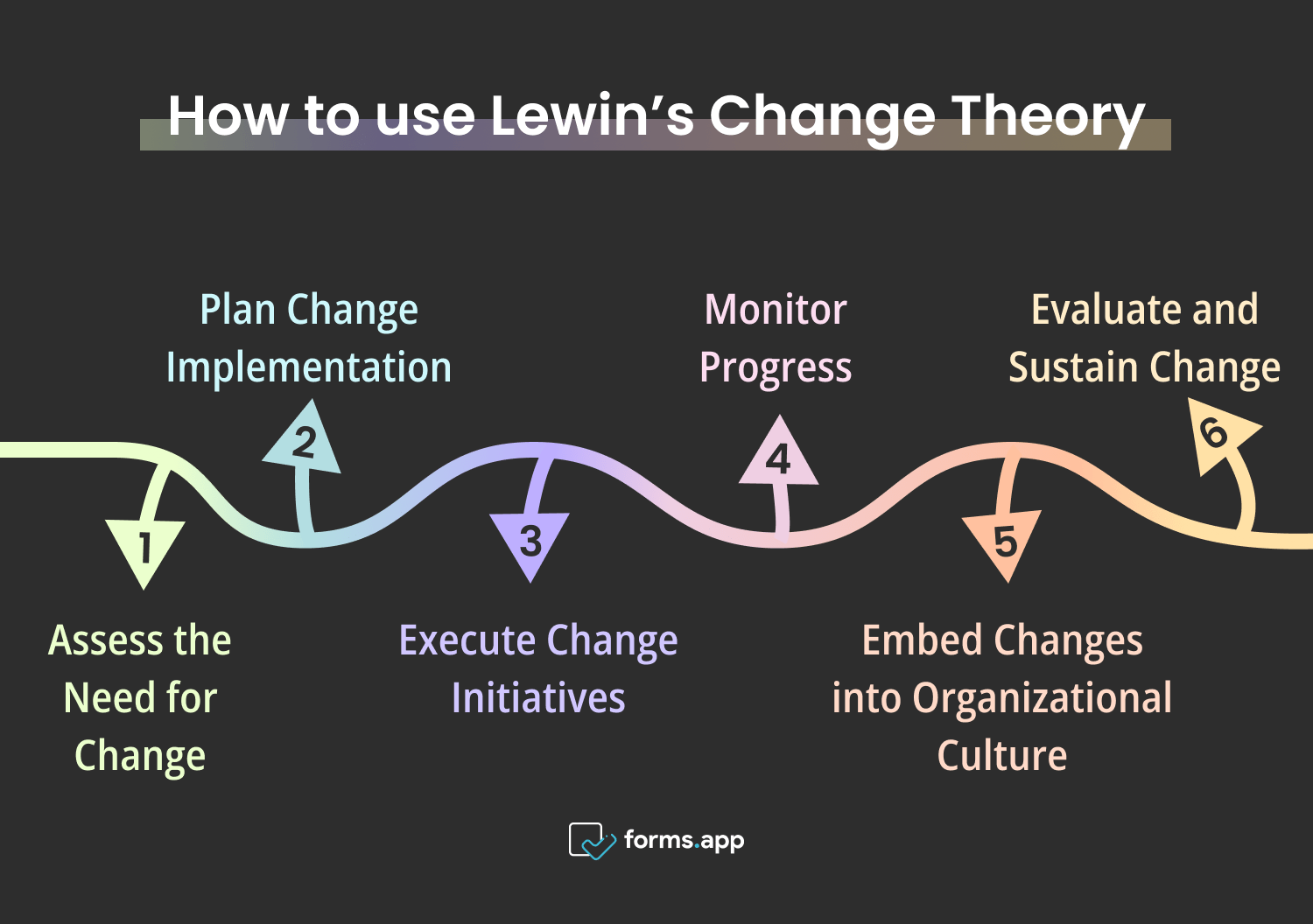
Change Theory steps
- Assess the Need for Change: Evaluate the current organizational structure and identify areas for improvement. Create a sense of urgency by highlighting the benefits of change and the potential risks of inaction. Engage stakeholders in the change process to gain buy-in and support.
- Plan Change Implementation: Develop a clear change management strategy outlining objectives, timelines, and responsibilities. Communicate the vision for change and align it with organizational goals. Provide resources and support to employees to facilitate the transition.
- Execute Change Initiatives: Implement changes systematically and transparently, keeping employees informed throughout the process. Address resistance to change by addressing concerns and emphasizing the benefits. Foster collaboration and teamwork among team members to ensure smooth implementation.
- Monitor Progress: Regularly assess progress towards change goals and adjust strategies as needed. Celebrate success and milestones achieved to maintain morale and motivation. Solicit feedback from employees to identify any challenges and address them promptly.
- Embed Changes into Organizational Culture: Integrate new behaviors and practices into daily operations and organizational norms. Align systems, processes, and policies with the desired changes for long-term sustainability. Foster a culture of continuous improvement and innovation.
- Evaluate and Sustain Change: Evaluate the effectiveness of change initiatives and their impact on organizational performance. Make necessary adjustments to ensure embedding changes in the organizational culture. Develop long-term strategies for sustaining change and fostering ongoing improvement.
Unfreeze Change Refreeze example
The Kurt Lewin Model of Change examples will show the model's application in real-world situations. You can explore these scenarios. This way, you'll gain deeper insights into how to effectively implement the theory within your organization. The model also enables driving positive change and achieving strategic objectives:
1- Company X: Textiles
In Company X, a textile firm, Lewin's Change Theory was instrumental in starting a changing process. The first step involved creating a sense of urgency among employees. It also included emphasizing the need to modernize operations and enhance competitive edge. Through effective communication and engagement, the company successfully unfroze existing patterns, paving the way for change implementation.
When it can, the company embarked on the change phase. Then, it restructured processes and integrated new technologies to streamline operations. This involved a collaborative effort, with employees actively participating in the redesigning of workflows and adopting innovative practices. As a result, the organization experienced improvements in efficiency, productivity, and product quality, aligning with its strategic objectives.
2- Company Y: Technology
At Company Y, a technology firm, Lewin's Change Theory guided the organization through a dynamic transformation journey. The process began with a thorough assessment of existing systems and structures, identifying areas for improvement and innovation. The company fostered a culture of adaptability and continuous learning. It successfully navigated the change phase, implementing new technologies and strategies to stay ahead of the competition.
The final stage focused on strengthening the changes and embedding them into the organizational culture. Through effective leadership and communication, the company reinforced the newly adopted practices, ensuring their long-term sustainability. As a result of these efforts, the organization witnessed significant improvements in operational efficiency, product development, and market position. It also drove growth and success in the technology sector.
3- Company Z: Shipping
For Company Z, a shipping company, Lewin's Change Theory played a pivotal role in driving organizational restructuring and performance improvement initiatives. The process began with a clear vision and strategy, outlining the company's objectives and desired outcomes. Through open communication and employee involvement, the company successfully unfroze existing processes, preparing them for change.
It implemented a series of strategic interventions (change phase), including process redesign, technology adoption, and skill development programs. This involved empowering employees to embrace change and adapt to new ways of working, promoting collaboration and innovation. As a result, the organization experienced enhanced operational efficiency, customer satisfaction, and overall performance in the competitive shipping industry.
Use cases of the Lewin’s Change Theory
Diverse industries and organizational settings benefit from the versatility of Lewin's Change Theory. Its adaptable framework finds application across sectors, driving initiatives in healthcare, education, government, manufacturing, non-profits, and corporate realms. Let's explore the use cases and discover the model's effectiveness in diverse environments.
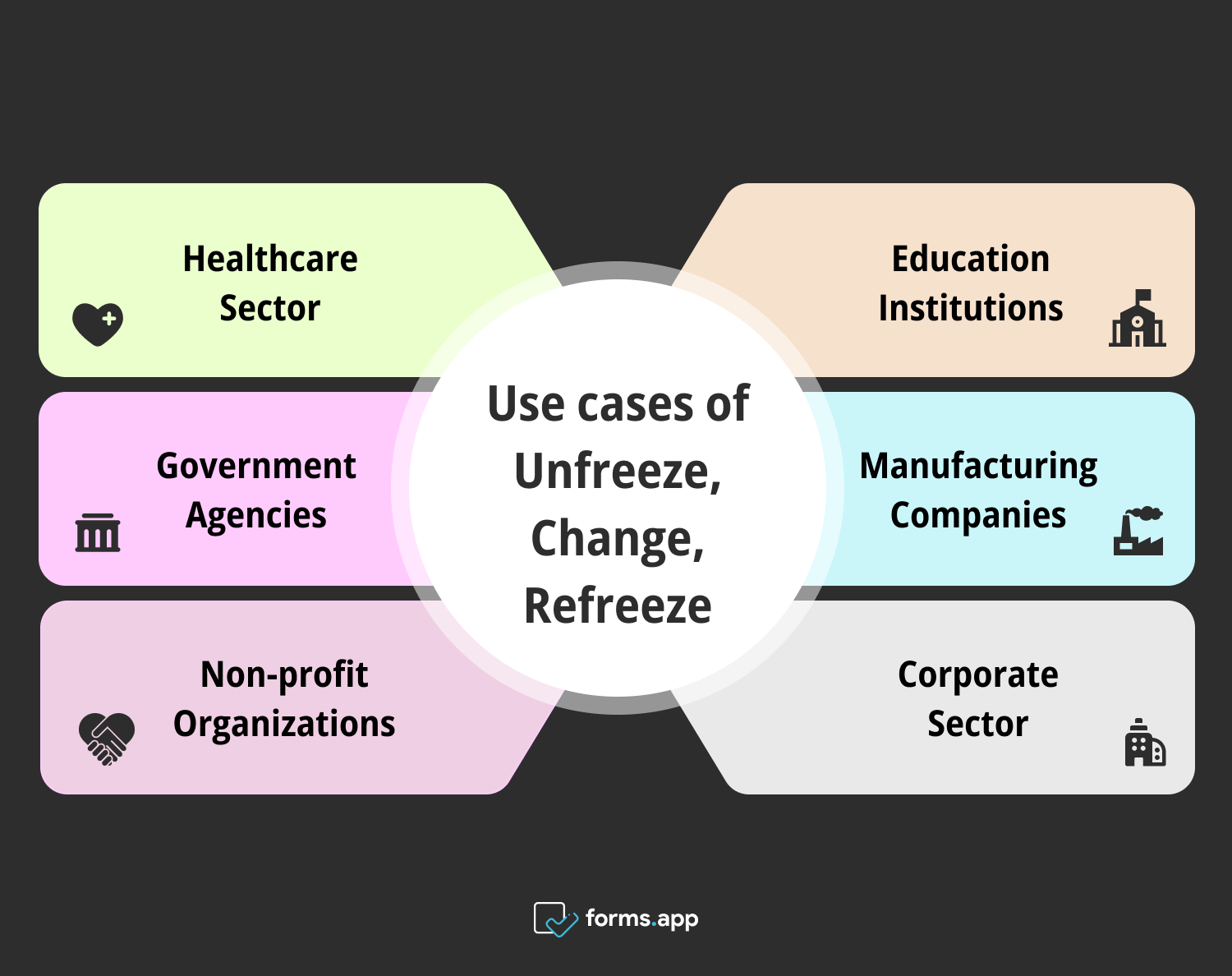
Different use cases of Lewin’s Change Theory
- Healthcare Sector: Hospitals use the theory to implement process improvements. These may include streamlining patient care pathways or adopting electronic health records. This enhances efficiency and patient outcomes while adapting to evolving healthcare needs.
- Education Institutions: Lewin's Change Theory facilitates curriculum redesign efforts in educational institutions, enabling smoother transitions to new teaching methodologies or learning technologies. It promotes student engagement and academic excellence through innovative educational approaches.
- Government Agencies: Government agencies leverage the theory to drive organizational restructuring initiatives, enhancing service delivery and responsiveness to citizens' needs. This fosters greater efficiency, transparency, and accountability in public administration.
- Manufacturing Companies: In the manufacturing sector, companies use Lewin's Change Theory to implement lean manufacturing principles. This optimizes production processes, minimizes waste, and improves overall operational efficiency.
- Non-profit Organizations: Non-profit organizations employ the theory to drive strategic initiatives, such as expanding community outreach programs or improving fundraising strategies. This enables them to fulfill their mission better and create a positive social impact.
- Corporate Sector: Corporations across various industries utilize Lewin's Change Theory to manage organizational transitions effectively. The theory provides a structured approach to change management, ensuring long-term success (i.e. implementing new technologies, restructuring departments, or fostering a culture of innovation).
Advantages & Disadvantages of the Lewin’s Change Theory
As with any organizational framework, Lewin's Change Theory presents both advantages and disadvantages. Business leaders must weigh these factors carefully to maximize the benefits and mitigate potential drawbacks. Let's explore the advantages and disadvantages of making informed decisions when implementing this model:
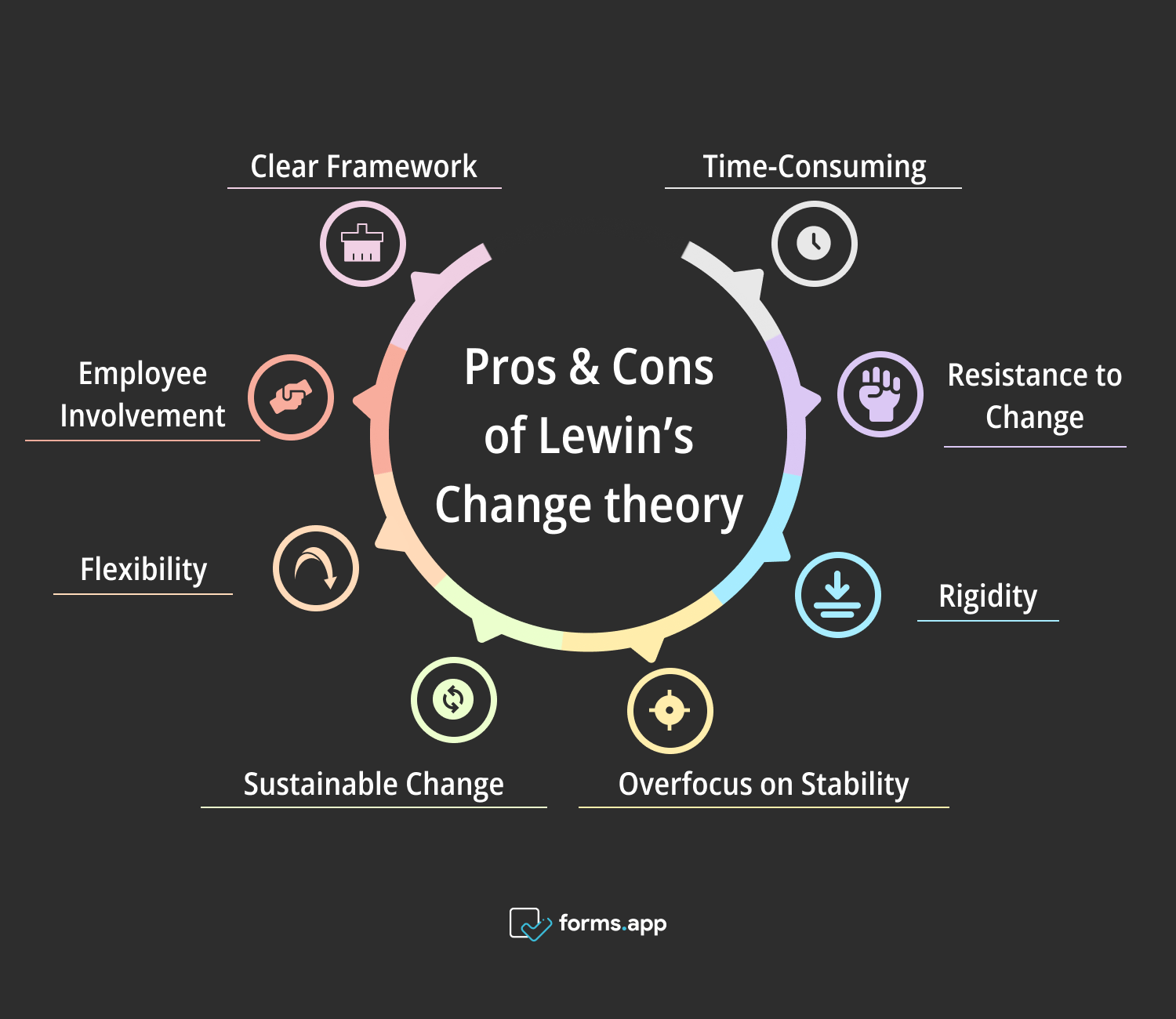
Pros & Cons of Unfreeze, Change, Refreeze
Advantages:
- Clear Framework: Lewin's model provides a structured approach, guiding organizations through distinct stages: unfreezing, changing, and refreezing. The goal is to achieve desired outcomes with clarity and focus.
- Employee Involvement: The model emphasizes active participation and involvement of employees. It leads to fostering a sense of ownership and commitment to the change process.
- Flexibility: With its adaptable nature, Lewin's model accommodates various organizational contexts and change initiatives, allowing for tailoring and flexibility in implementation.
- Sustainable Change: Addressing underlying behaviors and organizational dynamics is vital. Therefore, Lewin's model facilitates sustainable change, ensuring the integration of changes into the organizational culture for long-term effectiveness.
Disadvantages:
- Time-Consuming: Implementing Lewin's model requires significant time and resources, including planning, communication, and training efforts. These can prolong the change process and increase associated costs.
- Resistance to Change: Despite its dynamic approach, Lewin's model may encounter resistance from employees who are resistant to change. This leads to delays or disruptions in the implementation process.
- Rigidity: The model's structured framework may become overly rigid in dynamic environments, limiting adaptability and responsiveness to unforeseen challenges or emerging opportunities.
- Overfocus on Stability: Lewin's emphasis on refreezing to stabilize the organization post-change may hinder innovation and agility. It may potentially impede the organizational ability to respond to evolving market demands or technological advancements.
Key points to take away
In conclusion, Lewin's Change Theory offers a robust framework for managing organizational transitions effectively. Its versatility is evident across diverse sectors, including healthcare, education, government, manufacturing, non-profits, and corporate realms. Through adaptable strategies and structured approaches, organizations can navigate change with clarity, employee involvement, and sustainability.
In this article, we saw examples illustrating its practical application, driving improvements in efficiency, innovation, and performance. We covered the advantages, such as clear frameworks and sustainable change. We also mentioned the challenges like time consumption and resistance. If you understand its nuances and leverage its strengths, your business can achieve enduring success amidst organizational change.
Fatih is a content writer at forms.app and a translator specializing in many text domains, including medical, legal, and technical. He loves studying foreign languages. Fatih especially likes to create content about program management, organizational models, and planning tools.
